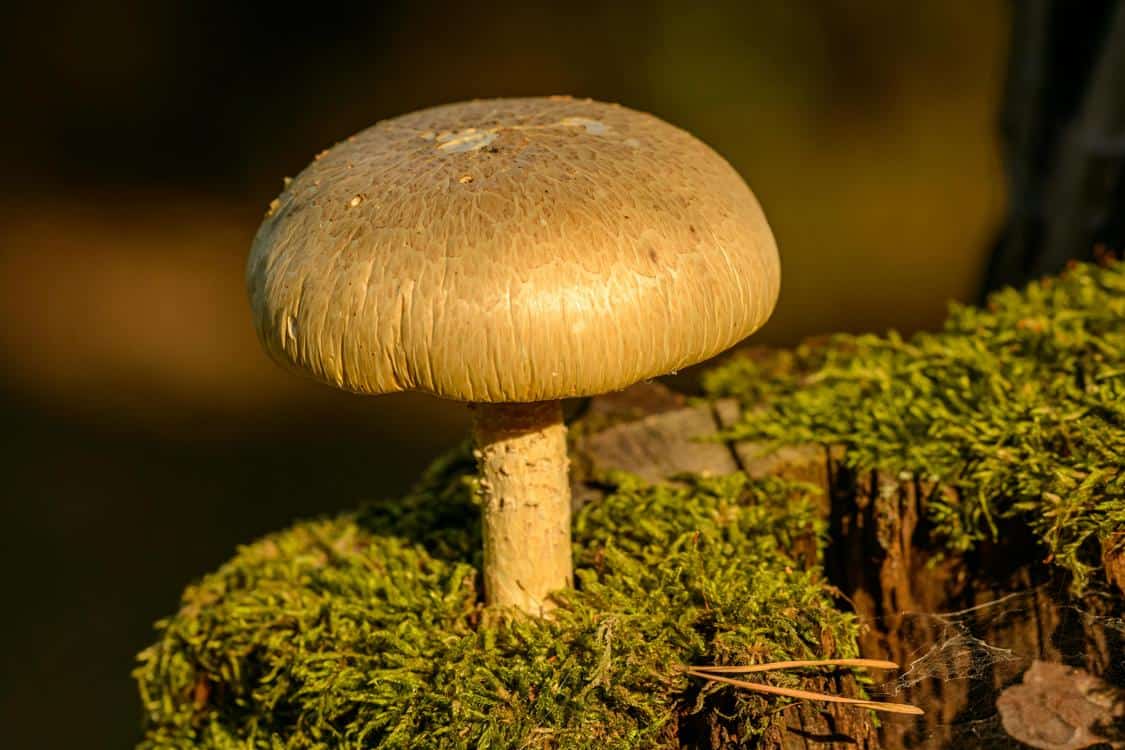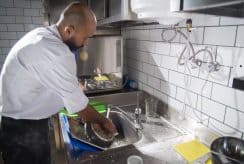Many mushroom cultivators use monotubs for their ease of use and effectiveness. They are commonly referred to as “tek” in the mushroom community, and for good reason.
Whether you purchase fully colonized grain spawn or colonize your own, the monotub method is a tried-and-true cultivation technique.
The holes drilled along the sides of the mono tub allow passive areas of air exchange to maintain humidity and help prevent dry spots.
Inoculation
If you want to harvest a fruiting mushroom, the inoculation process is where it all starts. This is done by placing fully colonized grain spawn on top of a layer of sterilized substrate. It is important to leave the monotub undisturbed for six to ten days, and not open it or check on the contents for any reason. Opening the monotub allows carbon dioxide to escape, increases colonization time and introduces contaminants. The only exception would be if you smell a rancid or foul odor indicating that the colonization is compromised.
The spawn should be fully inoculated and spread evenly over the substrate. The amount of spawn needed will vary depending on the species of mushroom you’re growing. It’s usually a good idea to purchase pre-made, fully inoculated grain spawn for the first few tries. This will simplify the cultivation process until you’re comfortable making your own.
After the spawn is evenly distributed, cover it with a layer of perlite to help maintain moisture and prevent contamination. Perlite is typically sold at “field capacity” and can be hydrated to that point by simply spraying it down with hydrogen peroxide. It’s important that the perlite doesn’t form puddles in the bottom of the monotub, as this could lead to bacterial contamination.
Once the spawn is covered with perlite, it’s time to place the monotub in a warm location for colonization. The ideal temperature for this is 77-80 degrees Fahrenheit, and it’s important to avoid direct sunlight or other sources of heat that can cause the spawn to dry out. It’s also important to not disturb the monotub for any reason during this time, as doing so may increase colonization times and potentially contaminate the spawn.
After the initial colonization, it’s a good idea to install a fan and a humidity controller in the monotub to optimize fresh air exchange, CO2 levels, and humidity for your chosen species of mushroom. To do this, remove the self-adhesive filters from one end of the monotub lid and cut a hole to mount a FAE Fan Mini and Myco-Mister Mini Humidifier with hose. In addition, SABS are essential for mushroom cultivation. Plug the fan into a cycle timer that controls the airflow duration and frequency based on your specific mushroom species needs.
Substrate
As the mycelium spreads out and colonizes your monotub, it creates an intricate network of white filaments known as hyphae. These hyphae provide a rich diversity of niches, stimulating enzyme activity and enhancing the development of distinct mushroom characteristics. Eventually, the mycelium will engulf your substrate completely and trigger a stage known as fruiting.
To encourage the mycelium to develop a rich substrate, it is important that you maintain ideal ambient humidity and temperature conditions within your monotub. These conditions will help to keep the bulk substrate hydrated, which is critical to mushroom development. For example, a substrate that is too dry will cause the mycelium to dehydrate and slow its growth. Similarly, an overly wet substrate will cause the mycelium to over-grow and develop a slimy texture that can block mycelial flow and inhibit fruiting.
While some cultivators use commercially-available fully colonized grain spawn to expedite their cultivation, many people choose to prepare and colonize their own substrates. This can be done by using readily-available ingredients like cow manure, straw, or wood shavings, or more specialized materials such as coir or vermiculite. The goal is to create a substrate that is easy to colonize, contains ample nutrients for healthy growth, and has the right texture to promote mycelial growth and pinning (the process by which mushrooms attach themselves to the substrate).
If you are using a bulk substrate such as manure or straw, you can also mix in other ingredients to help the substrate retain moisture and adjust its pH and nutritional content. For instance, some growers add worm castings to the substrate to improve nutrient availability and provide a balanced nutrient profile. Others add a layer of casing material, such as coco coir or peat moss, to simulate the natural casing layer found in nature.
The best way to hydrate your bulk substrate is to place it in a plastic storage tub or tote and fill it with a mixture of water and sterilized compostable organic material such as shredded newspaper, cardboard, or coffee grounds. Line the bin with the same material and poke holes in the top and sides of the tub to allow air to circulate. This allows fresh, cool air to come in through the top holes and mix with the moist nutrient-rich bulk substrate to hydrate it evenly.
Casing

A well-developed monotub casing layer is key to a successful harvest. It keeps contaminants out of the substrate, and it’s an essential way to maintain optimal moisture. It’s important to remove spent casing before preparing the substrate for the next flush, so the tub can be disinfected and ready for new material. This step is vital to ensure the growth of healthy mushrooms, maximizing yield in minimal space.
Grain spawn may be purchased pre-colonized, but it’s also easy to inoculate your own. You can use a sterilized grain container with a self-healing port to inject the spores or culture, or you can simply add them directly to the monotub sterile substrate and wait for them to fully colonize. Once the spawn is fully colonized, you can start fruiting.
The temperature of your grow room is an important factor in determining whether your monotub will successfully produce a full crop. A room that is too warm will dry out your spores, and a room that is too cold will slow down the colonization process. A hygrometer placed in your grow room will help you keep track of the humidity and temperature, which should be maintained at around 90% and 75% respectively.
Most commercially-available mushroom substrates are already pre-canned into a block that can be used to inoculate a monotub, but you can make your own by soaking the substrate in water. Then, mix the substrate with hydrated perlite to form a loose, even mixture. A block like this can be placed in your monotub and left to colonize for up to a month, depending on the ambient conditions of your room.
Older monotub directions often instruct cultivators to take off the lid and mist and fan the spawn multiple times throughout the day. While this can be useful for some species, doing so frequently can lead to contamination and slow the colonization process. It’s best to avoid this practice and instead use a fan or humidifier connected to an air cycle timer set to the specific needs of your monotub’s species.
When you’re ready to fruit, simply place your monotub in a sunny location. Be sure to mist the substrate occasionally so it stays moist, but not too much. You should be able to feel the substrate get slightly warmer and damp with each misting.
Light
While mushrooms themselves don’t need light to grow, the mycelium that colonizes the substrate requires a specific light spectrum to flourish and promote fruiting. This is why it’s important to ensure that the right conditions are present for mycelial development and substrate colonization in monotubs.
The first step is to properly construct the monotub, using a clear or transparent tote or storage tub with at least 6 holes, two on each long side and two near the ends. These holes allow for air exchange, reducing stress on the fungus and focusing growth towards the top of the monotub. Older directions often instruct cultivators to line the bottom of their monotubs with black spray paint, but our friends at North Spore have discovered that lining with an opaque contractor-style trash bag is a better option, as it prevents contamination from the sides of the tub.
Once the mycelium has fully colonized the sterile substrate, it’s time to introduce the monotub to indirect sunlight or an artificial light source that can mimic natural daylight. The ideal light spectrum for mushroom cultivation is in the 6500 to 7500 Kelvin range, which closely resembles the wavelength of natural sunlight and promotes mycelial development and substrate colonization. If possible, use an LED light that can be adjusted to the appropriate wavelength for your specific species of fungus.
Indirect sunlight and the right light spectrum will help to encourage mycelium growth throughout the substrate, resulting in healthy mushrooms with beautiful colors. It is also important to keep in mind that the temperature and humidity of your growing space will affect how well your mushrooms perform, so it’s a good idea to use a thermometer and hygrometer in your growing area to monitor these variables.
For the most successful monotub cultivation, we recommend using a timer or other light control system to ensure that your mushrooms receive the correct light duration throughout the day. This will prevent them from receiving too little or too much light, which can negatively impact their growth and fruiting potential. With the proper environmental controls, you’ll be able to successfully grow an amazing harvest of psilocybin-containing mushrooms in your own backyard.





